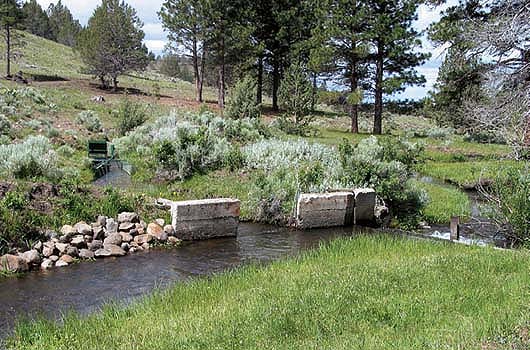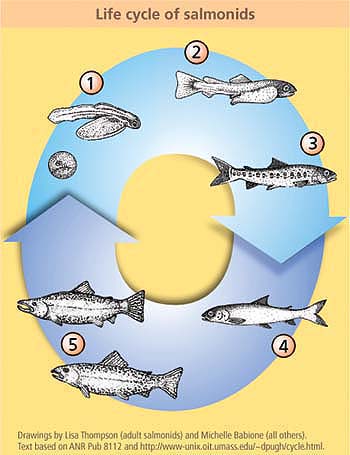All Issues
Monitoring aids control of ag-related stream-temperature increases
Publication Information
California Agriculture 59(3):149-150.
Published July 01, 2005
PDF | Citation | Permissions
Full text
California only has so much water to go around and using it in one place can have unintended — and undesirable — consequences in another. Take the Klamath River, where large-scale water diversions for agriculture contributed to low flows and warm waters in 2002, which in turn are blamed for this summer's dive in chinook salmon stocks. Likewise, salmon and other cold-water fish can suffer when warm irrigation water is discharged into streams. While the impacts are small individually, they can add up over an entire watershed, particularly in California where temperature-impaired streams and at-risk salmon populations overlap considerably.
In response to pressure from environmental groups over the salmon decline, agricultural discharge regulations for stream temperatures are now in the works. To help ranchers and other stakeholders comply with these upcoming temperature regulations, UC Cooperative Extension (UCCE) researchers are developing ways to monitor and mitigate stream temperatures ( see pages 153 , 161 ). “Our goal is to help ranchers and other stakeholders figure out what's going on in their creeks, and start seeing how management affects stream temperature,” says UCCE rangeland watershed specialist Kenneth Tate.
California has 10 populations of chinook, coho and steelhead that are federally listed as threatened or endangered. Fish in the salmon family depend on cold water for all stages of their life cycle, from migration to spawning to rearing. While the temperature requirements vary with species and age, the preferred ranges for growth and survival are generally 45°F to 58°F (see figure, page 150). “Higher temperatures are usually less than optimal and those above the upper seventies are usually lethal,” says UCCE anadromous and inland fisheries specialist, Lisa Thompson.
Irrigation systems can raise stream temperatures to the suboptimal or even lethal range. For example, flood-irrigation water can heat up as it crosses pastures, thus adding warm runoff to streams. Other types of land use that can increase stream temperatures include logging and grazing, which can reduce the riparian vegetation that shades and so keeps streams cool.
Regulations governing discharges of warm agricultural water into local streams are in place or in the works for many parts of California, to protect native fish species that require cold-water habitat.
Until recently, such agricultural discharges were allowed under a statewide waiver granted by the State Water Resources Control Board. Now, however, the regulations for agricultural discharge are in flux. In addition, the particulars vary from region to region because they are set individually by local water-quality control boards. For example, the Central Valley region (from Modoc County to Kern County) has adopted a conditional discharge waiver tied to a compliance process. In contrast, the North Coast region (from Del Norte/Siskiyou counties to Sonoma County) does not currently grant irrigation waivers.
“We have no plans for a waiver,” says Catherine Kuhlman, executive officer of the North Coast Water Quality Control Board (NCWQCB). “It is reasonable to forecast that at some point in the future, anyone in the state discharging pollutants that affect water quality will need to be covered by a waiver or permit. That said, it is going to take us awhile to get there.”
TMDLs and water quality
However, the North Coast region does have total maximum daily loads (TMDLs), which under the federal Clean Water Act address temperature and other pollutants that impair water quality. TMDLs entail first accounting for the pollutant sources in impaired waters and then developing and implementing plans for meeting water-quality standards. “The conditional discharge waivers and TMDLs are pushing agriculture to start complying with water-quality regulations,” says UCCE's Tate.
So far, temperature TMDLs in the North Coast region have focused primarily on streams and rivers in areas with timber. But that is about to change. Soon, streams and rivers in areas with sizeable rangelands and crop lands will also have temperature TMDLs. “The urgency is in the Scott and Shasta rivers, where TMDLs need to be adopted by December by court order,” says the NCWQCB's Kuhlman. Next on the horizon is the Klamath mainstem.
As a first step in preparing for these upcoming temperature TMDLs, Kuhlman advises ranchers to develop range management plans with help from agencies such as the Natural Resources Conservation Service, and by taking the UCCE Ranch Water Quality Planning Short Course (see California Agriculture, July-September 2004). Developed in partnership by the UCCE Rangeland Watershed Program, ranchers and state agencies, this short course helps ranchers reduce temperature and other water pollutants on rangelands. The short course also encourages landowners to form watershed management groups, which dovetails with the next step Kuhlman recommends for North Coast ranchers: monitoring stream temperatures on a watershed basis. “Comprehensive, collaborative monitoring, rather than landowner by landowner, makes the most sense for temperature,” she says.
Monitoring stream temperatures
Tate and a team of UCCE researchers have developed a process for collecting, analyzing and interpreting the data. “The challenge for UC in this rapidly changing regulatory climate is to identify research that will be helpful in the long term,” Tate says. “We chose monitoring because it will have value over time, no matter how the regulations change.”
The process entails repeatedly monitoring streams and analyzing the data, first to see if management practices are affecting streams and then to see if management changes that are intended to lower temperatures are actually working ( see pages 153 , 161 and 168 ). If not, ranchers may need to adjust their management further. For example, if reducing pasture runoff is not enough to make streams cooler, then ranchers could also try keeping cattle away from riparian areas to increase the vegetation that shades streams. Tate also strongly recommends monitoring for several critical variables in addition to stream temperature, including canopy cover and air temperature.
Since being incorporated into the UCCE ranch water quality short course, this monitoring method has resulted in the first case studies of stream-temperature monitoring in California rangelands and irrigated pastures. “These field studies show the real-world management challenges that local ranchers face every day, and how monitoring can help them make informed decisions to overcome these challenges,” Tate says. — Robin Meadows
The life stages of anadromous salmonids include those spent in fresh water (top), and saltwater (bottom). Steelhead species living in landlocked water bodies do not smolt, but otherwise their life cycles are similar. All salmonids depend on cool water temperatures. The length of each stage varies depending on species, stock and environment. (1) In late autumn, the female salmonid buries fertilized eggs in stream-bottom gravel nests. They develop and hatch into larval fish after 1 to 3 months, rear in stream gravel an additional 1 to 5 months, then emerge as (2) fry in spring or summer. (3) Fry and later stages of juvenile fish rear in the stream for several days to 4 years. (4) If the salmonid is going to migrate to the ocean, it will become a smolt some time between the age of a few days and 4 years. During smoltification, the fish's physiology changes to survive the transition from fresh to salt water. Smolts migrate to the ocean, usually in spring or early summer, and may spend time rearing in a river estuary. Fish live and grow in the ocean for 1 to 4 years. (5) In the spring, adult salmonids begin returning, usually to their native streams, to repeat the spawning cycle.
For more information
Central Valley Regional Water Quality Control Board/Discharges from Irrigated Lands
www.waterboards.ca.gov/centralvalley/programs/irrigated_lands/index.html
Klamath Resource Information System/North Coast Region Total Maximum Daily Loads Fact Sheet
www.krisweb.com/policy/tmdl_factsheet_northcoast.htm
UC Cooperative Extension/Nonpoint Sources of Pollution on Rangeland
http://danr.ucop.edu/uccelr/h03.htm
UC Cooperative Extension/Fishery Habitat: Temperature Requirements






